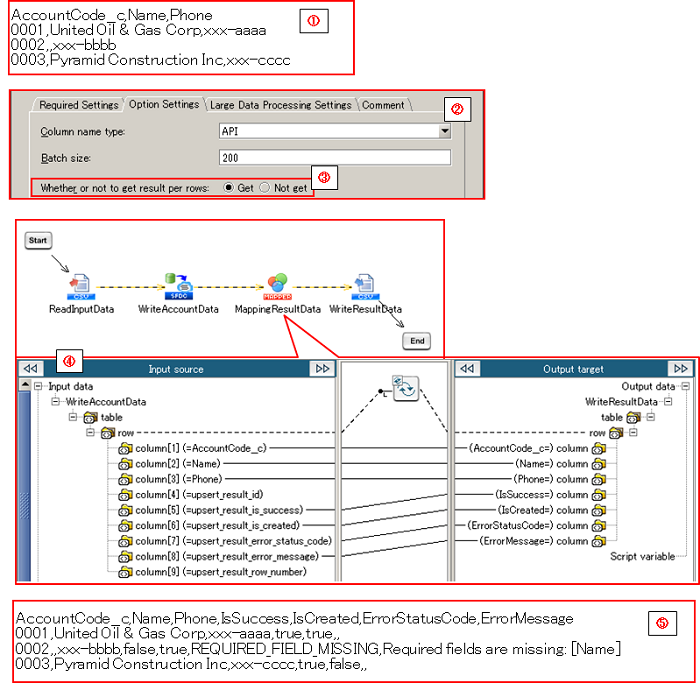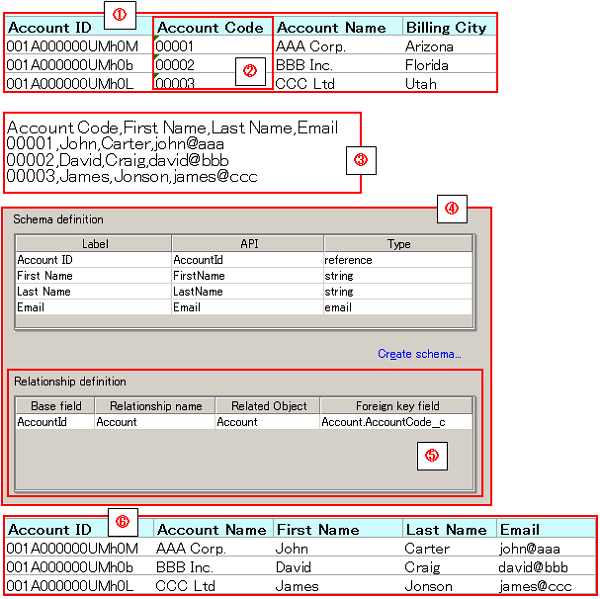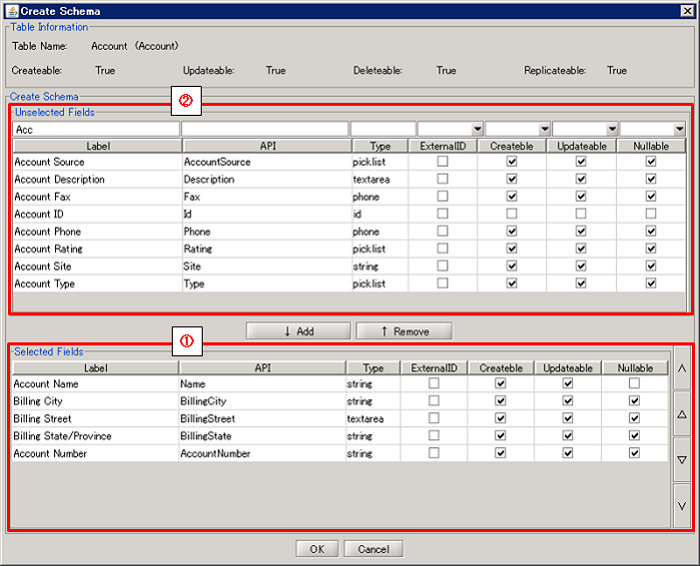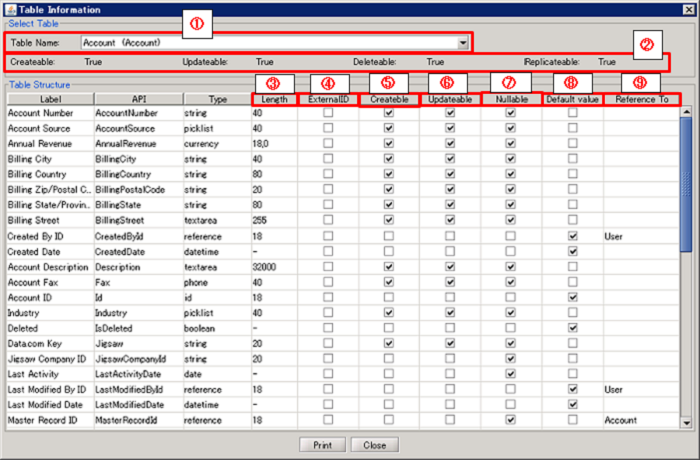| Item name |
Required/Optional |
Use of Variables |
Description |
Supplement |
| Destination |
Required |
Not Available |
Select Global Resources.
- [Add...]:
Add new global resource.
- [Edit...]:
Global resource settings can be edited by [Edit Resource list].
|
|
| Table Name |
Required |
Not Available |
Select the name of a table in Salesforce. |
|
| Schema definition |
Required |
- |
Set items subject to writing to Salesforce. |
 Limiting the settings to only items needed to be written to Salesforce (deleting unnecessary items from the Schema Definition) helps improve processing performance. Limiting the settings to only items needed to be written to Salesforce (deleting unnecessary items from the Schema Definition) helps improve processing performance.
|
| Schema definition/Key |
Required |
Not Available |
Select whether the target column of the table specified in [Table Name] is a key item for updating.
- [true]:Specify as a update key item
- [false]:Do not specify as a update key item
|
|
| Schema definition/Label |
Required |
Not Available |
Display the lable name of the column of the table specified in [Table Name]. |
|
| Schema definition/API |
Required |
Not Available |
Display the API name of the column of the table specified in [Table Name]. |
|
| Schema definition/Type |
Required |
Not Available |
Display the data type of the row of the table specified in [Table Name]. |
|
| Relationship definition |
Optional |
- |
In the case that relationship items exist in the Schema Definition, set items subject to updating by external key.
By selecting the external key item of the relation counterpart object, it becomes possible to pass data with an established relationship. |
 Available on API 14.0 or later versions, and cannot be used on API 7.0. Available on API 14.0 or later versions, and cannot be used on API 7.0. For details, please refer to Relationship Definition. For details, please refer to Relationship Definition.
|
| Relationship definition/Base field |
Required |
Not Available |
Display the API Name of the row of the relation item of the table specified in [Table Name]. |
|
| Relationship definition/Relationship name |
Required |
Not Available |
Display the relationship name of the row of the relation item of the table specified in [Table Name]. |
|
| Relationship definition/Related Object |
Optional |
Not Available |
Select the API Name of the relation counterpart object in the relation item column of the table specified in [Table Name]. |
|
| Relationship definition/Foreign key field |
Optional |
Not Available |
Select the external key item of the relation counterpart object in the relation item column of the table specified in [Table Name]. |
- If omitted, the ID of the relevant record of the relation counterpart object will be passed.
|
| Item name |
Required/Optional |
Use of Variables |
Description |
Supplement |
| Column name type |
Required |
Not Available |
Choose the display type of the column name, for displaying the schema in mapping.
- [Label]:
The label name (item name) defined in Salesforce is displayed.
- [API] :(default)
The API reference name defined in Salesforce is displayed.
|
|
| Batch size |
Required |
Available |
Specify a batch size for performing the write data operation on Salesforce. |
- The default value is "200".
- A number of 1 or greater, up to 200, can be set. An error occurs if any number outside of this range is set.
- Depending on the operating environment, increasing the batch size generally helps improve the performance of the write data operation.
 According to the Salesforce adapter specifications, if you set a batch size to 200 when writing 10,000 records, the write operation is performed in 50 installments. According to the Salesforce adapter specifications, if you set a batch size to 200 when writing 10,000 records, the write operation is performed in 50 installments.
|
| Writing Method |
Required |
Not Available |
Select either to add/update or only to update data to Salesforce.
- [Update and Insert]:
The update process is executed if the input data exist in Salesforce, and the insert process is executed if not.
- [Update only]:(default)
The update process is executed if the input data exist in Salesforce, and no process is executed if not.
|
|
| Handling of null values |
Required |
Not Available |
Select, in the case that the input data is null for the update target field, either to overwrite the field by null or to skip it.
- [Field value to null]:(default)
If the input data is null, the update target field is overwritten by null.
- [Skip null values]:
If the input data is null, the update of the target field is skipped and it remains the same.
If the input data is not null, the update target field is overwritten by the input data.
|
|
| Whether or not to get result per rows |
Required |
Not Available |
Specify whether or not to obtain results, after writing to Salesforce.
- [Get]:(default)
Obtain the results of the write data operation.
- [Do Not Get]:
Do not obtain the results of the write data operation
|
- If [Get] is selected, items specified in the Schema and items showing results can be passed to the subsequent processing as data in Table Model type.
 Please refer to Schema about the obtained information. Please refer to Schema about the obtained information. Please refer to Usage Examples of Get Results for usage examples. Please refer to Usage Examples of Get Results for usage examples.
|
| Base64 field input form |
Required |
Not Available |
Specify the input data type of items in Base 64 data type.
- [Base64 data]:(default)
Base64 Data is inserted.
- [File path]:
File path is inserted.
|
|
| Item name |
Description |
Supplement |
| Display Table Information... |
You can check the table structure of the object you are operating.
 For more information on how to view the table structure, please refer to Display Table Information For more information on how to view the table structure, please refer to Display Table Information |
 Click [Load All Table Information....] if you would like to check the table structure of other objects. Click [Load All Table Information....] if you would like to check the table structure of other objects. |
| Load All Table Information... |
Retrieve all possible table information
After running, you can verify the retrieved information from [Table Information]. |
|
| Read schema definition from file... |
Select a file from the file chooser and read the name of field API on the first line of the file specified in the comma-separated values. Set this as the schema definition. |
- Please specify "UTF-8" encoding for the selected file.
|
| Element Name |
Column Name(Label/API) |
Description |
Supplement |
| row |
- |
Repeats as many times as the number of processings performed based on the data given to the input schema.
For example, if two data records are updated by one input data record, this element would be repeated two times.
|
- If [Do Not Get]is selected in [Whether or not to get result per rows], the repetition will be 0 times.
 If mismatch data exist, such as that data types do not match, the order of input data and output data will not necessarily match. By specifying [Update_Result_Row_Number/update_result_row_number] as the order condition, the data can be sorted in accordance to the input data in the subsequent Mapper. If mismatch data exist, such as that data types do not match, the order of input data and output data will not necessarily match. By specifying [Update_Result_Row_Number/update_result_row_number] as the order condition, the data can be sorted in accordance to the input data in the subsequent Mapper.
|
| column |
update_result_id |
Salesforce ID is output. |
|
| update_result_is_success |
Success Flag is output.
- [true]:Successfully processed
- [false]:Process failed. Please check the [update_result_error_status_code] as well as [update_result_error_message].
|
|
| update_result_is_created |
Create Flag is output.
- [true]:A record is created.
- [false]:No record is created.
|
|
| update_result_error_status_code |
The status code, returned by the Salesforce API, is output. |
- In the below-mentioned case, the Salesforce adapter will output the code and message.
- SALESFORCE_ADAPTER_ILLEGAL_DATA_TYPE
This is set when the defined item type and input data type do not match. For example, if the item is defined as "double" but a character string is input (not a number).
- SALESFORCE_ADAPTER_DATA_NOT_FOUND
This is set when the target data is searched in Saleforce but cannot be found, in the case that key in Schema Definition contain items other than ID and also "Update" is selected in [Writing Mode].
|
| update_result_error_message |
The message returned by the Salesforce API is output. |
| update_result_row_number |
Number is output based on the placement of the node within the data given to the input schema. |
|
| Component Variable Name |
Description |
Supplement |
| insert_count |
The number of data that was successful in the addition processing is stored. |
- The default value is null.
|
| update_count |
The number of data that was successful in the updating processing is stored. |
- The default value is null.
|
| error_count |
The number of data that was unsuccessful in the addition or updating processing is stored. |
- The default value is null.
 In the case that all the conditions below are satisfied, input data whose update targets do not exist are not included in the count. In the case that all the conditions below are satisfied, input data whose update targets do not exist are not included in the count.
The number of input data whose update targets do not exist is stored in [not_exist_count].
- [Update only] is selected in [Writing method]
- [Get] is selected in [Whether or not to get result per rows]
- [Key] contains items other than ID in [Schema definition]
|
| not_exist_count |
The number of input data whose updating target data do not exist is stored. |
- The default value is null.
- The value is not stored if any of the conditions below is not satisfied.
- [Update only] is selected in [Writing method]
- [Get] is selected in [Whether or not to get result per rows]
- [Key] contains items other than ID in [Schema definition]
|
| read_count |
The number of input data is stored. |
- The default value is null.
|
| server_url |
The end point URL after Login is stored. |
- The default value is null.
|
| session_id |
The session Id is stored. |
- The default value is null.
|
| message_category |
In the case that an error occurs, the category of the message code corresponding to the error is stored. |
- The default value is null.
|
| message_code |
In the case that an error occurs, the code of the message code corresponding to the error is stored. |
- The default value is null.
|
| message_level |
In the case that an error occurs, the importance of the message code corresponding to the error is stored. |
- The default value is null.
|
| operation_api_exception_code |
The ExceptionCode of the occured error, in a case of API error, is stored. |
- The default value is null.
- For any error other than an API Error, the value is not stored.
 The content to be stored may change according to the version of DataSpider Servista. The content to be stored may change according to the version of DataSpider Servista.
|
| operation_error_message |
If an error occurs, the error message of the occured error is stored. |
- The default value is null.
 The content to be stored may change according to the version of DataSpider Servista. The content to be stored may change according to the version of DataSpider Servista.
|
| operation_error_trace |
When an error occurs, the trace information of the occured error is stored. |
- The default value is null.
 The content to be stored may change according to the version of DataSpider Servista. The content to be stored may change according to the version of DataSpider Servista.
|
| Number in the Image |
Name |
Description |
Supplement |
| (1) |
Table Name |
Select the table whose structure to be shown. |
|
| (2) |
Table Information |
Display the available operations on the selected table. |
|
| (3) |
Length |
Display the Number of Digit of item |
|
| (4) |
External ID |
Display whether or not the object item is set as an external ID. |
|
| (5) |
Createble |
Display whether or not it can be set a value when adding data. |
|
| (6) |
Updatable |
Display whether or not it can be set a value when updating data. |
|
| (7) |
Nullable |
Display whether or not it can be set NULL when adding or updating data. |
|
| (8) |
Default value |
Display whether or not Salesforce automatically set a default value when adding data. |
|
| (9) |
Reference To |
Display the referring object name if the item is in reference relationship or master-servant relationship. |
|
| Exception Name |
Reason |
Resolution |
ResourceNotFoundException
Resource Definition is Not Found. Name:[] |
[Destination] is not specified. |
Specify [Destination]. |
ResourceNotFoundException
Resource Definition is Not Found. Name:[<Global Resource Name>] |
The resource definition selected in [Destination] cannot be found. |
Verify the global resource specified in [Destination] |
| java.net.UnknownHostException |
This exception occurs when the PROXY server specified in the global resource cannot be found. |
Verify the condition of the PROXY server. Or verify [Proxy host] of the global resource specified in the [Destination]. |
- API 23.0 or earlier
org.apache.commons.httpclient.HttpConnection$ConnectionTimeoutException
- API 26.0 or later
java.net.SocketTimeoutException
connect timed out
|
A time-out has occurred while connecting to Salesforce. |
Verify the network condition and Salesforce server condition. Or check [Connection timeout(sec)] of the global resource specified in the [Destination]. |
- API 23.0 or earlier
org.apache.commons.httpclient.HttpRecoverableException
java.net.SocketTimeoutException: Read timed out
- API 26.0 or later
java.net.SocketTimeoutException
Read timed out
|
A time-out has occurred while waiting for a responce from the server after connecting to Salesforce. |
Verify the network condition and Salesforce server condition. Or check [Timeout(sec)] of the global resource specified in the [Destination]. |
| jp.co.headsol.salesforce.adapter.exception.SalesforceAdapterIllegalArgumentException |
Invalid value is set for the property of Salesforce adapter. |
Check the error message, and verify the settings. |
| com.sforce.soap.partner.fault.LoginFault |
Login to Salesforce has failed. |
Check the ExceptionCode or error message, and refer to the information about this type of error in Salesforce-related documents etc. |
| com.sforce.soap.partner.fault.UnexpectedErrorFault |
An unexpected error has occured while processing to Salesforce. |
Check the ExceptionCode or error message, and refer to the information about this type of error in Salesforce-related documents etc. |
 Limiting the settings to only items needed to be written to Salesforce (deleting unnecessary items from the Schema Definition) helps improve processing performance.
Limiting the settings to only items needed to be written to Salesforce (deleting unnecessary items from the Schema Definition) helps improve processing performance. For details, please refer to Writing Method and Specifying a Key for Updating.
For details, please refer to Writing Method and Specifying a Key for Updating. Available on API 14.0 or later versions, and cannot be used on API 7.0.
Available on API 14.0 or later versions, and cannot be used on API 7.0. For details, please refer to Relationship Definition.
For details, please refer to Relationship Definition.



